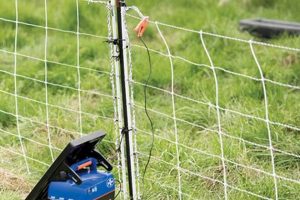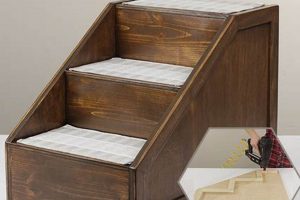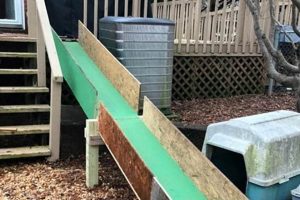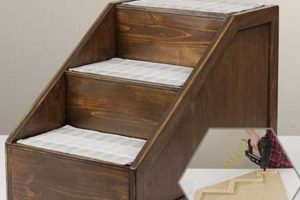Constructing a customized canine bathing area offers a dedicated space for pet hygiene routines. This involves creating a designated area, whether indoors or outdoors, equipped with features that facilitate the efficient and comfortable cleaning of dogs. For example, a homeowner might convert a section of their garage into a tiled enclosure with a raised platform and a handheld showerhead.
Such an undertaking provides numerous advantages, including reduced mess within the home, improved comfort for the animal during bathing, and potential cost savings compared to professional grooming services. Historically, pet owners often resorted to bathing their animals in bathtubs or outdoor areas, leading to inconvenience and potential damage to household fixtures. A dedicated structure addresses these challenges by offering a purpose-built solution.
The following sections will detail considerations for planning, constructing, and maintaining a customized canine cleaning space, offering a comprehensive guide for those interested in creating such a facility.
Building a Customized Canine Cleaning Area
The following recommendations aim to ensure a successful and practical outcome when undertaking the creation of a dedicated space for canine bathing.
Tip 1: Planning and Location. Carefully evaluate the intended location. Indoor options like a garage or laundry room offer climate control but may require plumbing modifications. Outdoor spaces necessitate weather protection and proper drainage.
Tip 2: Size and Ergonomics. Determine appropriate dimensions based on the size of the dog(s) to be bathed. Consider a raised platform to minimize strain on the individual performing the washing.
Tip 3: Plumbing and Drainage. Adequate plumbing is crucial. Ensure sufficient hot water supply and a properly installed drain to prevent blockages and water damage. A hair trap is highly recommended.
Tip 4: Materials Selection. Opt for waterproof and non-slip materials for flooring and walls. Tile, sealed concrete, or durable plastic are suitable choices. Consider materials that are easy to clean and resistant to mold and mildew.
Tip 5: Fixtures and Accessories. Select a handheld showerhead with adjustable spray settings for efficient rinsing. Install appropriate shelving or storage for shampoos, towels, and grooming tools.
Tip 6: Safety Features. Implement safety measures such as non-slip surfaces and a secure restraint system to prevent the dog from slipping or jumping during the bathing process.
Tip 7: Ventilation. Proper ventilation is important, especially in indoor settings, to prevent moisture buildup and the growth of mold. Consider installing an exhaust fan or ensuring adequate airflow.
Adherence to these recommendations will contribute to a functional, safe, and long-lasting canine cleaning area that simplifies pet hygiene routines.
The subsequent section will provide guidance on the ongoing care and upkeep of the facility to maximize its lifespan and effectiveness.
1. Planning
Effective planning is paramount for the successful creation of a dedicated canine bathing area. A structured approach to initial considerations ensures the resulting structure meets the specific needs of the user and the animal, while also minimizing potential issues during construction and long-term use.
- Location Assessment
Location analysis involves evaluating potential sites based on available space, plumbing accessibility, drainage capabilities, and existing infrastructure. Indoor locations like garages or mudrooms offer climate control but require plumbing modifications. Outdoor locations necessitate weather protection. Careful consideration of these factors directly influences project feasibility and long-term convenience.
- Needs Analysis
A comprehensive needs analysis identifies the specific requirements of the project, including the size and breed of the dog(s) to be bathed, the frequency of bathing, and any specific health considerations. This analysis dictates the dimensions of the bathing area, the required water temperature, and the necessity for specialized features like adjustable height platforms or restraint systems.
- Budget Allocation
Developing a detailed budget is critical for controlling project costs and preventing overspending. This involves estimating the expenses associated with materials, plumbing modifications, drainage installation, and any professional labor required. Prioritizing essential features and exploring cost-effective alternatives are key components of effective budget management.
- Design and Layout
A well-defined design and layout optimizes functionality and safety. This includes determining the optimal placement of fixtures, the selection of non-slip surfaces, and the incorporation of storage solutions for bathing supplies. A carefully considered design minimizes mess, enhances user comfort, and promotes a positive bathing experience for the animal.
These planning facets form a cohesive framework that guides the entire creation process. Addressing each area thoughtfully increases the likelihood of a successful and durable canine bathing area, tailored to the specific requirements of the user and the animal. Neglecting these preliminary steps can result in costly modifications, functional limitations, and compromised safety.
2. Location
The selection of an appropriate location is a foundational element in the successful implementation of a customized canine bathing structure. Location directly influences the feasibility, cost, and long-term functionality of the installation. Considerations include access to plumbing, drainage capabilities, available space, and environmental factors. The location must accommodate the physical dimensions of the intended structure and facilitate the efficient execution of canine hygiene routines.
Indoor locations, such as garages, laundry rooms, or basements, offer advantages in terms of climate control and protection from the elements. However, they may necessitate more extensive plumbing modifications and potentially require enhanced ventilation to mitigate moisture buildup. Conversely, outdoor locations, while potentially simpler in terms of plumbing access, are subject to weather fluctuations and may necessitate the construction of a protective enclosure. A homeowner in a temperate climate might opt for an open-air structure, while one in a region with harsh winters would require a fully enclosed and insulated space. Furthermore, the proximity to existing utilities and the ease of waste disposal significantly impact both construction costs and ongoing operational efficiency.
Ultimately, the optimal location balances practical considerations with budgetary constraints and individual preferences. A careful assessment of these factors ensures that the chosen site supports the effective and sustainable operation of the canine bathing area, promoting both the well-being of the animal and the convenience of the owner. Overlooking the importance of location can lead to increased expenses, functional limitations, and ultimately, dissatisfaction with the completed project.
3. Materials
The selection of materials directly determines the functionality, durability, and safety of a customized canine bathing area. Material choices impact resistance to water damage, ease of cleaning, and the prevention of slips and falls. Inadequate material selection can lead to structural degradation, unsanitary conditions, and potential injury to the animal or the user. For instance, porous materials like untreated wood are susceptible to mold growth and water damage, rendering them unsuitable for wet environments. Conversely, non-porous materials such as ceramic tile or sealed concrete offer superior water resistance and are easily cleaned, making them ideal for flooring and wall surfaces. Therefore, the appropriate selection of materials is not merely aesthetic but fundamentally crucial to the station’s utility and longevity.
Considerations extend beyond water resistance to encompass chemical resistance and non-slip properties. Many cleaning products contain harsh chemicals that can degrade certain materials over time. Selecting materials resistant to these chemicals ensures the longevity of the installation and prevents costly repairs. Furthermore, incorporating non-slip surfaces, such as textured tiles or rubber mats, minimizes the risk of accidents, particularly when bathing wet dogs. For example, epoxy grout, known for its chemical resistance and impermeability, is a superior choice compared to standard cementitious grout in areas exposed to frequent cleaning. The practical application of these material considerations results in a safer, more hygienic, and more durable bathing environment.
In summary, the materials employed are integral to the overall performance and longevity of a custom canine bathing facility. Prioritizing water resistance, chemical resistance, and non-slip properties is paramount. While initial cost may influence material selection, the long-term benefits of durable, easy-to-maintain, and safe materials outweigh the potential savings of cheaper, less suitable options. The informed selection of materials directly translates to a more effective and enduring solution for canine hygiene.
4. Drainage
Effective drainage is an indispensable element in the construction of a customized canine bathing facility. The absence of adequate drainage mechanisms precipitates water accumulation, fostering unsanitary conditions, promoting the growth of mold and mildew, and potentially causing structural damage to the surrounding environment. Poor drainage, therefore, directly undermines the hygienic objectives and long-term viability of such a structure. A malfunctioning or inadequate drainage system creates an environment conducive to bacterial proliferation, posing a health risk to both the animal and the user. The implications of deficient drainage extend beyond mere inconvenience, potentially incurring significant remediation costs related to water damage and mold removal.
The design and implementation of the drainage system must account for several factors, including the volume of water used during bathing, the frequency of bathing, and the type of flooring material employed. Incorporating a properly sized drain connected to a municipal sewer system or a dedicated septic tank is essential. Additionally, the installation of a hair trap is crucial to prevent clogging and maintain the system’s operational efficiency. Consider the example of a homeowner who installs a custom dog wash station in their basement without adequate drainage infrastructure. The subsequent accumulation of water leads to the development of mold and mildew, necessitating costly repairs and remediation efforts. Conversely, a properly designed and installed drainage system effectively removes wastewater, preventing these problems and ensuring the longevity of the facility.
In summary, appropriate drainage is not an ancillary consideration but a fundamental requirement for the successful operation of a customized canine bathing station. Neglecting this aspect can result in significant financial and health-related consequences. Implementing a well-designed drainage system, incorporating appropriate components such as drains, hair traps, and proper connections to the existing plumbing infrastructure, is vital for maintaining a hygienic, safe, and durable environment for canine bathing. The integration of effective drainage solutions mitigates the risks associated with water accumulation and ensures the continued functionality of the facility.
5. Ergonomics
The application of ergonomic principles to the design and construction of a customized canine bathing area directly impacts the user’s physical well-being and the efficiency of the bathing process. Incorporating ergonomic considerations mitigates the risk of strain, injury, and discomfort, thereby enhancing the overall experience for both the pet owner and the animal. A failure to address ergonomic factors can lead to musculoskeletal issues, reduced efficiency, and a diminished willingness to engage in regular canine hygiene routines.
- Working Height Optimization
Adjusting the working height of the bathing area is paramount for reducing strain on the back, shoulders, and knees. Raising the bathing surface to an appropriate level, typically between waist and chest height, minimizes the need for excessive bending or reaching. A raised platform or adjustable-height tub facilitates a more comfortable posture, particularly during extended bathing sessions. Example: A user who habitually bends over a low bathtub to bathe their dog is at increased risk of developing lower back pain, a risk significantly mitigated by a raised bathing platform.
- Reach and Accessibility
Ensuring easy reach to essential bathing supplies, such as shampoos, conditioners, and towels, minimizes unnecessary stretching and twisting motions. Strategically positioned shelving or storage compartments within easy reach reduce physical strain. An example of poor ergonomic design would be a setup where the user must repeatedly walk away from the bathing area to retrieve necessary items, increasing the risk of slips and falls and disrupting the bathing process.
- Footing and Support
Providing stable and supportive footing for the user is crucial for maintaining balance and preventing falls. Non-slip flooring surfaces and the availability of a sturdy step stool or platform enhance stability and reduce the risk of slips and trips. Example: A user standing on a wet, slippery surface while attempting to control a wet, energetic dog is at significant risk of losing their balance, potentially resulting in injury to both the user and the animal.
- Equipment Design
The design of bathing equipment, such as showerheads and grooming tools, should prioritize user comfort and ease of use. Lightweight, adjustable showerheads with ergonomic grips reduce hand and wrist fatigue. Grooming tools with comfortable handles and efficient designs minimize repetitive motions and strain. Example: A heavy, unwieldy showerhead requiring constant pressure to operate increases hand and wrist fatigue, particularly during longer bathing sessions. An ergonomically designed showerhead, on the other hand, distributes weight evenly and requires minimal effort to control.
These ergonomic considerations, when integrated into the creation of a customized canine bathing station, promote a more comfortable, efficient, and safe environment for both the user and the animal. The strategic implementation of these principles mitigates the risk of physical strain and injury, enhancing the overall experience and fostering a more positive attitude toward canine hygiene routines. Ignoring ergonomic factors introduces unnecessary risks and detracts from the overall value and utility of the customized bathing facility.
6. Fixtures
The selection and integration of appropriate fixtures are pivotal in determining the functionality and user experience of a customized canine bathing area. These fixed components directly influence the efficiency of the bathing process, the ease of cleaning, and the overall aesthetic appeal of the structure. Careful consideration must be given to the selection and placement of each fixture to ensure optimal performance and durability.
- Showerheads
The choice of showerhead dictates the water flow, spray pattern, and overall rinsing effectiveness. Handheld showerheads with adjustable spray settings offer versatility and control, enabling targeted cleaning and efficient rinsing of various coat types. Fixed showerheads, while less versatile, may provide a more consistent water flow. The selection should be based on the size and coat characteristics of the dogs being bathed and the user’s preferences. A low-flow showerhead, for example, conserves water but may be inadequate for thick-coated breeds.
- Faucets and Plumbing
Durable and reliable faucets are essential for controlling water temperature and flow. Thermostatic mixing valves maintain a consistent water temperature, preventing scalding and ensuring a comfortable bathing experience for the animal. The plumbing connections must be properly installed and sealed to prevent leaks and water damage. A single-handle faucet simplifies operation, while separate hot and cold water controls offer more precise temperature adjustments. The materials used in the faucet construction should be corrosion-resistant to withstand prolonged exposure to water and cleaning agents.
- Tubs and Platforms
The size, material, and configuration of the tub or platform directly impact the comfort and safety of the bathing process. A raised platform reduces the need for bending, minimizing strain on the user’s back. Non-slip surfaces prevent slips and falls, ensuring the safety of both the animal and the user. Stainless steel tubs offer durability and ease of cleaning, while plastic tubs are lighter and more affordable. The tub or platform must be large enough to accommodate the largest dog being bathed, allowing for freedom of movement and preventing overcrowding.
- Storage Solutions
Integrated storage solutions, such as shelves, cabinets, and hooks, provide convenient access to bathing supplies and grooming tools. Strategic placement of storage compartments minimizes clutter and promotes a more organized and efficient bathing process. Waterproof materials and corrosion-resistant hardware are essential for withstanding the humid environment. Open shelving allows for quick access to frequently used items, while closed cabinets protect supplies from water damage and dust. The storage solutions should be designed to accommodate the specific needs of the user, providing ample space for shampoos, conditioners, towels, and grooming tools.
The selection and integration of these fixtures are integral to the overall success of a customized canine bathing area. Careful consideration of their functionality, durability, and ergonomic design is essential for creating a safe, efficient, and enjoyable bathing experience. The proper selection of fixtures, combined with thoughtful planning and construction, results in a valuable asset that simplifies pet hygiene routines and enhances the well-being of both the animal and the user.
Frequently Asked Questions
The following addresses common inquiries regarding the planning, construction, and maintenance of customized canine bathing facilities, providing clarity on key considerations and dispelling potential misconceptions.
Question 1: Is a building permit required for constructing a canine bathing area?
Permitting requirements vary based on location and the extent of the project. Significant plumbing or structural alterations may necessitate a permit. Consulting local building codes is advisable to ensure compliance and avoid potential penalties.
Question 2: What is the optimal flooring material for a canine bathing area?
Non-porous, slip-resistant materials are most suitable. Options include ceramic tile, sealed concrete, and certain types of vinyl flooring. Textured surfaces enhance traction, minimizing the risk of slips and falls.
Question 3: How can water temperature be regulated to ensure canine comfort and safety?
Thermostatic mixing valves offer precise temperature control, preventing scalding and maintaining a consistent water temperature. A temperature range of 95-100 degrees Fahrenheit is generally considered safe and comfortable for most dogs.
Question 4: Is specialized drainage necessary for a canine bathing area?
A dedicated drainage system is highly recommended to prevent water accumulation and potential water damage. A drain connected to the existing plumbing infrastructure, equipped with a hair trap, effectively removes wastewater and minimizes the risk of clogs.
Question 5: What measures can be taken to minimize noise during the bathing process?
Noise can be mitigated through the use of sound-dampening materials and techniques. Installing acoustic panels or using sound-absorbing insulation in the walls and ceiling can reduce echo and minimize disturbances to surrounding areas.
Question 6: What is the recommended maintenance schedule for a canine bathing area?
Regular cleaning is essential to maintain hygiene and prevent the growth of mold and mildew. Surfaces should be cleaned and disinfected after each use. Periodic inspections of the drainage system and plumbing connections are also recommended to identify and address potential issues early on.
These responses provide a foundational understanding of common questions related to canine bathing area construction. Further research and consultation with qualified professionals may be necessary to address specific project requirements and ensure a successful outcome.
The subsequent section will summarize the key benefits and considerations associated with constructing a custom canine bathing facility.
Concluding Remarks on Canine Bathing Area Construction
This exploration of “build your own diy dog wash station” underscores the importance of meticulous planning, strategic material selection, and adherence to ergonomic principles. Successful implementation hinges on addressing location suitability, plumbing and drainage requirements, and the integration of appropriate fixtures. Neglecting these considerations can compromise the functionality, longevity, and safety of the resulting structure.
The decision to undertake such a project represents a significant investment in pet care and home improvement. A well-executed canine bathing area provides a dedicated, hygienic space, minimizing mess and maximizing convenience. Diligent adherence to the guidelines presented herein will contribute to a lasting and valuable addition to the household, promoting both animal well-being and owner satisfaction. Therefore, thorough preparation and careful execution are paramount for realizing the full potential of this undertaking.







